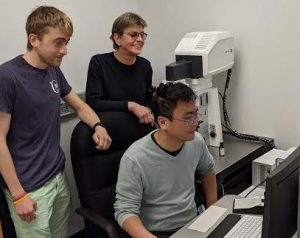CSHL’s Linda Van Aelst links genetic disorder to poor stress response
By Daniel Dunaief
Different people respond to the same level of stress in a variety of ways. For some, a rainy Tuesday that cancels a picnic can be a minor inconvenience that interrupts a plan, while others might find such a disruption almost completely intolerable, developing a feeling of helplessness.
Scientists and clinicians have been working from a variety of perspectives to determine the cause of these different responses to stress.

Cold Spring Harbor Laboratory Professor Linda Van Aelst and a post doctoral researcher in her lab, Minghui Wang, recently published a collaborative work that also included graduate student Nicholas Gallo, postdoctoral researcher Yilin Tai and Professor Bo Li in the journal Neuron that focused on the gene Oligophrenin-1, which is also implicated in intellectual disability.
As with most X-linked diseases, the OPHN1 mutation primarily affects boys, who have a single X chromosome and a Y chromosome. Girls have two X chromosomes, giving them a backup gene to overcome the effect of an X-linked mutation.
In addition to cognitive difficulties, people with a mutation in this gene also develop behavioral challenges, including difficulty responding to stress.
In a mouse model, Wang and Van Aelst showed that the effect of mutations in this gene mirrored the stress response for humans. Additionally, they showed that rescuing the phenotype enabled the mouse to respond more effectively to stress.
“For me and [Wang], it’s very exciting,” Van Aelst said. “We came up with this mouse model” and with ways to counteract the effect of this mutated analogous gene.
As with many other neurological and biological systems, Oligophrenin1 is involved in a balancing act in the brain, creating the right mix of excitation and inhibition.
When oligophrenin1 was removed from the prelimbic region of the medical prefrontal cortex, a specific brain area that influences behavioral responses and emotion, mice expressed depression-like helpless behaviors in response to stress. They then uncovered two brain cell types critical for such behavior: the inhibitory neurons and excitatory pyramidal neurons. The excitatory neurons integrate many signals to determine the activity levels in the medial prefrontal cortex.
The inhibitory neurons, meanwhile, dampen the excitatory signal so they don’t fire too much. Deleting oligophrenin1 leads to a decrease in these inhibitory neurons, which Van Aelst found resulted from elevated activity of a protein called Rho kinase.
“The inhibitor keeps the excitatory neurons in check,” Van Aelst said. “If you have a silencing of the inhibitory neurons, you’re going to have too much excitatory response. We know that contributes to this maladaptive behavior.”
Indeed, Wang and Van Aelst can put their metaphorical finger on the scale, restoring the balance between excitation and inhibition with three different techniques.
The scientists used an inhibitor specific for a RhoA kinase, which mimicked the effect of the missing Oligophrenin1. They also used a drug that had the same effect as oligophrenin1, reducing excess pyramidal neuron activity. A third drug activated interneurons that inhibited pyramidal neurons, which also restored the missing inhibitory signal. All three agents reversed the helpless phenotype completely.
Japanese doctors have used the Rho-kinase inhibitor fasudil to treat cerebral vasospasm. which Van Aelst said does not appear to produce major adverse side effects. It could be a “promising drug for the stress-related behavioral problems” of oligophrenin1 patients, Van Aelst explained in an email. “It has not been described for people with intellectual disabilities and who also suffer from high levels of stress.”

Van Aelst said she has been studying this gene for several years. Initially, she found that it is a regulator of rho proteins and has linked it to a form of intellectual disability. People with a mutation in this gene had a deficit in cognitive function that affected learning and memory.
From other studies, scientists learned that people who had this mutation also had behavioral problems, such as struggling with stressful situations.
People with intellectual difficulties have a range of stressors that include issues related to controlling their environment, such as making decisions about the clothing they wear or the food they eat.
“People underestimate how many [others] with intellectual disabilities suffer with behavioral problems in response to stress,” Van Aelst said. “They are way more exposed to stress than the general population.”
Van Aelst said she and Wang focused on this gene in connection with a stress response.
Van Aelst wanted to study the underlying cellular and molecular mechanism that might link the loss of function of oligophrenin1 with the behavioral response to stress.
At this point, Van Aelst hasn’t yet studied how the mutation in this gene might affect stress hormones, like cortisol, which typically increase when people or mice are experiencing discomfort related to stress. She plans to explore that linkage in future studies.
Van Aelst also plans to look at some other genes that have shown mutations in people who battle depression or other stress-related conditions. She hopes to explore a genetic link in the brain’s circuitry to see if they can “extend the findings.” She would also like to connect with clinicians who are studying depression among the population with intellectual disabilities. Prevalence studies estimate that 10 to 50 percent of individuals with intellectual disability have some level of behavioral problems and/or mood disorders.
Reflecting the reality of the modern world, in which people with various conditions or diseases can sequence the genes of their relatives, Van Aelst said some families have contacted her because their children have mutations in oligophrenin1.
“It’s always a bit tricky,” she said. “I don’t want to advise them yet” without any clinical studies.
A resident of Huntington, Van Aelst arrived at CSHL in the summer of 1993 as a post doctoral researcher in the lab of Michael Wigler. She met Wigler when he was giving a talk in Spain.
After her post doctoral research ended, she had planned to return to her native Belgium, but James Watson, who was then the president of the lab, convinced her to stay.
Outside of work, Van Aelst enjoys hiking, swimming and running. Van Aelst speaks Flemish, which is the same as Dutch, French, English and a “bit of German.”
She is hopeful that this work may eventually lead to ways to provide a clinical benefit to those people with intellectual disabilities who might be suffering from stress disorders.







